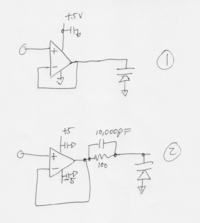jgraygoza
Member level 1

- Joined
- Dec 28, 2011
- Messages
- 37
- Helped
- 3
- Reputation
- 6
- Reaction score
- 3
- Trophy points
- 1,298
- Location
- California
- Activity points
- 1,647
Hello everyone.
I have a very small and simple question.
What is the best way to fast switch a varactor diode?
I ask this because I built a couple of tunable filters using varactor diodes and they work pretty well,
except the fact that they are very slow in switching.
I have built other filters using pin diodes and they are pretty fast.
But I am looking into the possibility that I could make one using varactors to meet size limitations.
Any suggestions would be greatly appreciated.
Thank you very much!
I have a very small and simple question.
What is the best way to fast switch a varactor diode?
I ask this because I built a couple of tunable filters using varactor diodes and they work pretty well,
except the fact that they are very slow in switching.
I have built other filters using pin diodes and they are pretty fast.
But I am looking into the possibility that I could make one using varactors to meet size limitations.
Any suggestions would be greatly appreciated.
Thank you very much!


